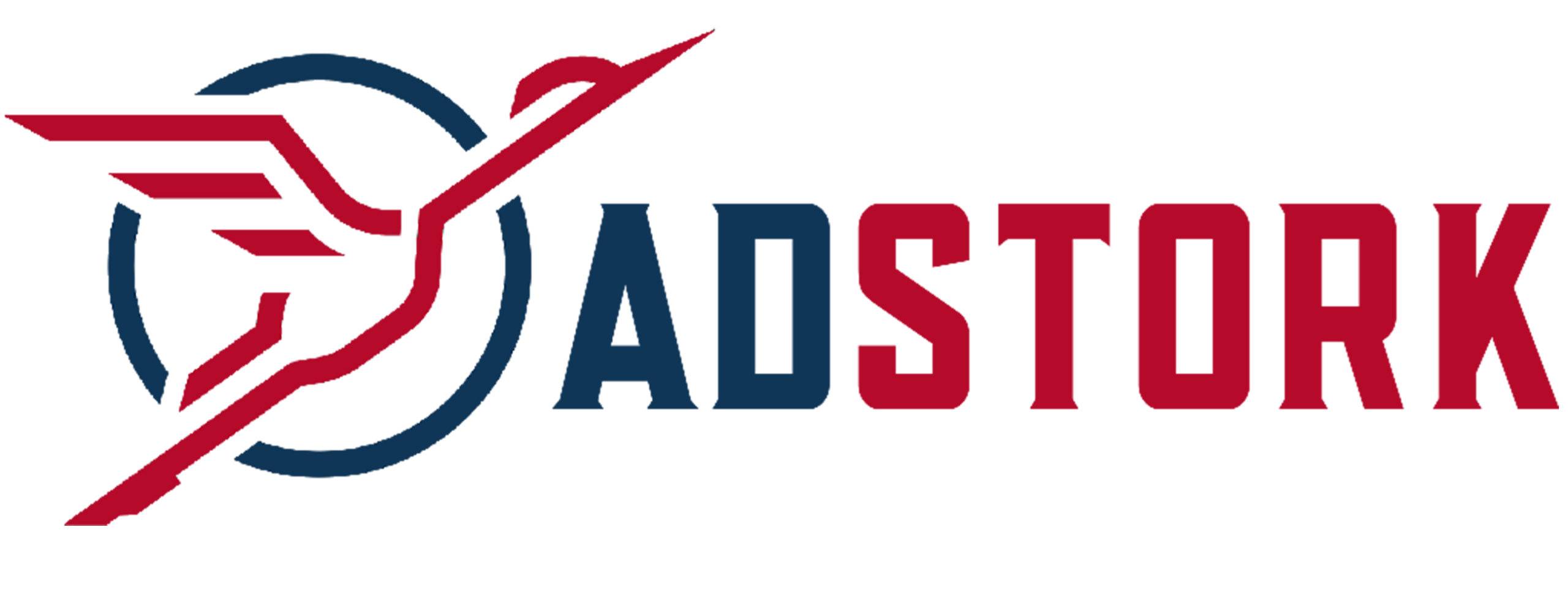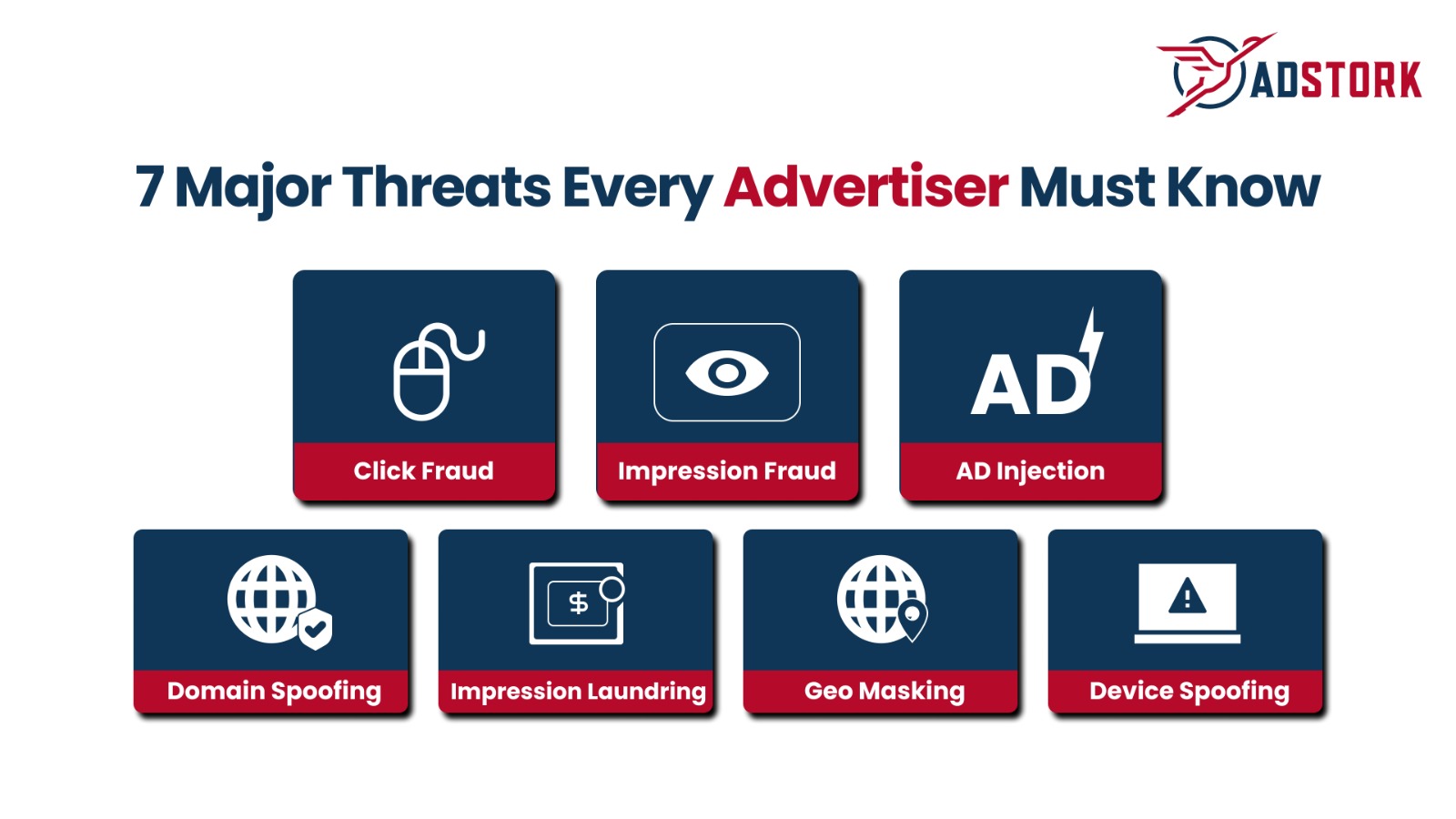- August 25, 2025
- by Adstork
Understanding Digital Ad Fraud: 7 Major Threats Every Advertiser Must Know
Introduction
Digital advertising powers global business growth, but it also faces a constant and expensive threat: ad fraud. According to industry reports, advertisers lose tens of billions of dollars each year to fraudulent activity. Fraudsters use sophisticated techniques to drain budgets, manipulate performance metrics, and reduce trust in the digital ad ecosystem.
To run effective campaigns, advertisers need to understand how fraud works. This blog covers the 7 major types of ad fraud that every marketer should know. We’ll explain how each tactic works, why it’s harmful, and what you can do to prevent it.
1. Click Fraud
Click fraud occurs when fraudulent actors such as bots, competitors, or organized click farms generate fake clicks on ads. While your reporting system may show high click-through rates (CTR), the clicks themselves have no genuine user intent.
Fraudsters often use automated scripts or large groups of low-cost workers to simulate clicks. In some cases, publishers may deliberately inflate clicks to earn more revenue from advertisers.
Why It’s Dangerous:
- Rapidly drains advertising budgets.
- Produces misleading performance metrics.
- Results in poor ROI and wasted resources.
How to Protect Yourself:
- Use dedicated click-fraud detection tools.
- Track suspicious spikes in CTR and sudden traffic surges.
- Exclude high-risk IP addresses or geographies.
2. Impression Fraud
Impression fraud manipulates the number of ad impressions without showing ads to real people. Two common methods are ad stacking (loading multiple ads in a single placement where only one is visible) and pixel stuffing (shrinking ads into a single invisible pixel).
Why It’s Dangerous:
- Distorts reach and viewability metrics.
- Misleads advertisers into overvaluing campaigns.
- Damages trust between advertisers and publishers.
How to Protect Yourself:
- Work with verification partners like DoubleVerify or IAS.
- Measure viewability rates instead of raw impressions.
- Prioritize trusted ad exchanges and premium publishers.
3. Domain Spoofing
Domain spoofing tricks advertisers into believing their ads are running on reputable websites when they are actually placed on low-quality or fraudulent sites. Fraudsters manipulate the URL data in the ad request to disguise their traffic.
Why It’s Dangerous:
- Budgets are wasted on poor-quality placements.
- Brands risk reputational damage by being shown on harmful sites.
- Advertisers lose confidence in programmatic systems.
How to Protect Yourself:
- Buy ads only from ads.txt-compliant publishers.
- Use whitelists of verified domains.
- Rely on DSPs and SSPs with strong transparency practices.
4. Ad Injection
Ad injection occurs when malware, browser extensions, or unauthorized applications insert ads directly into a publisher’s website or app without consent.
Why It’s Dangerous:
- Publishers lose ad revenue.
- Advertisers have no control over placement.
- Brands risk association with irrelevant or unsafe content.
How to Protect Yourself:
- Monitor ad placements regularly.
- Partner with ad networks that detect malware-driven fraud.
- Use brand safety tools to control where ads appear.
5. Bot Traffic & Botnets
Bot traffic refers to non-human traffic generated by automated programs. Sophisticated botnets (networks of infected devices) can simulate browsing behavior, clicks, and even form submissions.
Why It’s Dangerous:
- Skews engagement data and analytics.
- Leads to wasted ad spend with no return.
- Makes optimization decisions unreliable.
How to Protect Yourself:
- Deploy bot detection and filtering software.
- Monitor for unusual patterns such as identical session durations or non-human browsing behavior.
- Block suspicious IP ranges and devices.
6. Geo Masking
In geo masking, fraudsters disguise traffic from low-value regions and resell it as high-value traffic from premium markets. They achieve this through VPNs, proxies, or IP manipulation.
Why It’s Dangerous:
- Misleads advertisers about audience targeting.
- Results in higher costs for irrelevant audiences.
- Reduces campaign performance and market accuracy.
How to Protect Yourself:
- Use IP intelligence tools to validate geo-data.
- Monitor campaign performance across geographies.
- Partner with networks that apply strict geo-validation checks.
7. Affiliate Ad Fraud
Affiliate ad fraud happens when dishonest affiliates use tricks to claim commissions without driving real value. Tactics include cookie stuffing, fake leads, and traffic laundering.
Why It’s Dangerous:
- Direct revenue losses from fraudulent commissions.
- Polluted lead databases with fake or low-quality contacts.
- Erodes trust in affiliate and influencer programs.
How to Protect Yourself:
- Track the quality of traffic and conversions from affiliates.
- Use fraud detection solutions that flag suspicious activity.
- Set clear performance metrics and enforce compliance checks.
How Adstork Protects Your Campaigns (Benefits & Use Cases)
- Click & Impression Verification: Detects fake clicks and impressions through AI-driven monitoring and advanced behavioral analytics.
- Secure Ad Delivery: Prevents ad injection and ensures ads appear on verified domains.
- Traffic Source Transparency: Tracks impressions, clicks, and ad paths to uncover domain spoofing and impression laundering.
- Geo & Device Accuracy: Confirms geographic and device authenticity to block spoofing and improve targeting.
- Performance & ROI: Accurate reporting and analytics allow advertisers to optimize campaigns effectively.
- Brand Safety: Ensures ads appear only in safe, high-quality environments.
- Real-Time Monitoring & Alerts: Proactive fraud detection reduces budget loss and campaign disruption.
Conclusion
Ad fraud is a persistent threat that can drain advertising budgets, distort performance data, and weaken entire campaigns. By understanding the common types of ad fraud and working with a trusted partner like Adstork, businesses can ensure their ads reach real people and not bots. Our advanced fraud prevention safeguards brand safety, improves campaign accuracy, and maximizes ROI, so every marketing dollar truly works toward growth and long-term success.
FAQs
1. How does Adstork detect click and impression fraud?
AI-driven algorithms monitor patterns, device IDs, and behavioral signals to filter out invalid traffic
2. Can Adstork verify domain and ad placement authenticity?
Yes. We provide full transparency and verify that your ads appear only on legitimate, premium domains.
3. How do you handle geo-masking and device spoofing?
We combine IP verification, device fingerprinting, and behavioral analytics to ensure campaigns reach genuine users in the right locations.
4. What are the key benefits of working with Adstork?
Budget protection, accurate analytics, improved ROI, brand safety, verified ad placements, and proactive fraud prevention.


